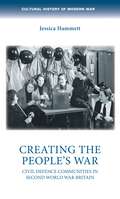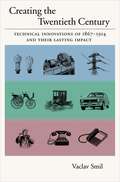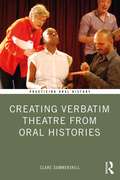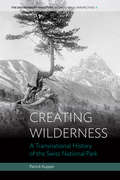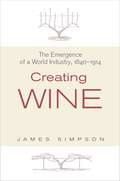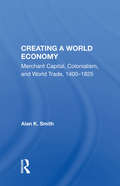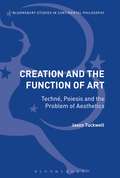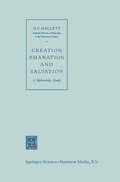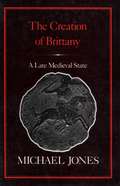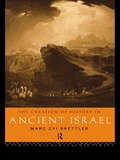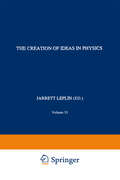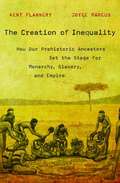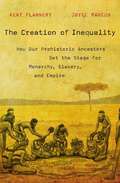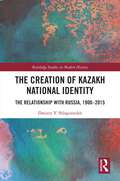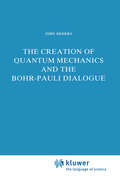- Table View
- List View
Creating the people’s war: Civil defence communities in Second World War Britain (Cultural History of Modern War)
by Jessica HammettWhy has the ‘people’s war’ been such a durable and attractive myth? Creating the people’s war examines how civil defence personnel engaged with this narrative during the war and in the following decades to answer this question. Civil defence was the most significant voluntary organisation of the Second World War, involving millions of men and women of every class, generation and locality in Britain. This book shows how local communities of civil defence personnel co-developed narratives about the value of their work which challenged hierarchies of war service. In their social groups volunteers wrote themselves into the ‘people’s war’ and invested it with meaning, creating national identity from the bottom up. Community was both central to these representations and vital for their production.
Creating the Suburban School Advantage: Race, Localism, and Inequality in an American Metropolis (Histories of American Education)
by John L. RuryCreating the Suburban School Advantage explains how American suburban school districts gained a competitive edge over their urban counterparts. John L. Rury provides a national overview of the process, focusing on the period between 1950 and 1980, and presents a detailed study of metropolitan Kansas City, a region representative of trends elsewhere.While big-city districts once were widely seen as superior and attracted families seeking the best educational opportunities for their children, suburban school systems grew rapidly in the post–World War II era as middle-class and more affluent families moved to those communities. As Rury relates, at the same time, economically dislocated African Americans migrated from the South to center-city neighborhoods, testing the capacity of urban institutions. As demographic trends drove this urban-suburban divide, a suburban ethos of localism contributed to the socioeconomic exclusion that became a hallmark of outlying school systems. School districts located wholly or partly within the municipal boundaries of Kansas City, Missouri, make for revealing cases that illuminate our understanding of these national patterns.As Rury demonstrates, struggles to achieve greater educational equity and desegregation in urban centers contributed to so-called white flight and what Senator Daniel Patrick Moynihan considered to be a crisis of urban education in 1965. Despite the often valiant efforts made to serve inner city children and bolster urban school districts, this exodus, Rury cogently argues, created a new metropolitan educational hierarchy—a mirror image of the urban-centric model that had prevailed before World War II. The stubborn perception that suburban schools are superior, based on test scores and budgets, has persisted into the twenty-first century and instantiates today's metropolitan landscape of social, economic, and educational inequality.
Creating the Twentieth Century: Technical Innovations of 1867-1914 and Their Lasting Impact
by Vaclav SmilThe period between 1867 and 1914 remains the greatest watershed in human history since the emergence of settled agricultural societies: the time when an expansive civilization based on synergy of fuels, science, and technical innovation was born. At its beginnings in the 1870s were dynamite, the telephone, photographic film, and the first light bulbs. Its peak decade - the astonishing 1880s - brought electricity - generating plants, electric motors, steam turbines, the gramophone, cars, aluminum production, air-filled rubber tires, and prestressed concrete. And its post-1900 period saw the first airplanes, tractors, radio signals and plastics, neon lights and assembly line production. This book is a systematic interdisciplinary account of the history of this outpouring of European and American intellect and of its truly epochal consequences. It takes a close look at four fundamental classes of these epoch-making innovations: formation, diffusion, and standardization of electric systems; invention and rapid adoption of internal combustion engines; the unprecedented pace of new chemical syntheses and material substitutions; and the birth of a new information age. These chapters are followed by an evaluation of the lasting impact these advances had on the 20th century, that is, the creation of high-energy societies engaged in mass production aimed at improving standards of living.
Creating the Twentieth Century: Technical Innovations of 1867-1914 and Their Lasting Impact
by Vaclav SmilThe period between 1867 and 1914 remains the greatest watershed in human history since the emergence of settled agricultural societies: the time when an expansive civilization based on synergy of fuels, science, and technical innovation was born. At its beginnings in the 1870s were dynamite, the telephone, photographic film, and the first light bulbs. Its peak decade - the astonishing 1880s - brought electricity - generating plants, electric motors, steam turbines, the gramophone, cars, aluminum production, air-filled rubber tires, and prestressed concrete. And its post-1900 period saw the first airplanes, tractors, radio signals and plastics, neon lights and assembly line production. This book is a systematic interdisciplinary account of the history of this outpouring of European and American intellect and of its truly epochal consequences. It takes a close look at four fundamental classes of these epoch-making innovations: formation, diffusion, and standardization of electric systems; invention and rapid adoption of internal combustion engines; the unprecedented pace of new chemical syntheses and material substitutions; and the birth of a new information age. These chapters are followed by an evaluation of the lasting impact these advances had on the 20th century, that is, the creation of high-energy societies engaged in mass production aimed at improving standards of living.
Creating Verbatim Theatre from Oral Histories (Practicing Oral History)
by Clare SummerskillOffering a roadmap for practicing verbatim theatre (plays created from oral histories), this book outlines theatre processes through the lens of oral history and draws upon oral history scholarship to bring best practices from that discipline to theatre practitioners. This book opens with an overview of oral history and verbatim theatre, considering the ways in which existing oral history debates can inform verbatim theatre processes and highlights necessary ethical considerations within each field, which are especially prevalent when working with narrators from marginalised communities. It provides a step-by-step guide to creating plays from interviews and contains practical guidance for determining the scope of a theatre project: identifying narrators and conducting interviews, developing a script from excerpts of interview transcripts and outlining a variety of ways to create verbatim theatre productions. By bringing together this explicit discussion of oral history in relationship to theatre based on personal testimonies, the reader gains insight into each field and the close relationship between the two. Supported by international case studies that cover a wide range of working methods and productions, including The Laramie Project and Parramatta Girls, this is the perfect guide for oral historians producing dramatic representations of the material they have sourced through interviews, and for writers creating professional theatre productions, community projects or student plays.
Creating Verbatim Theatre from Oral Histories (Practicing Oral History)
by Clare SummerskillOffering a roadmap for practicing verbatim theatre (plays created from oral histories), this book outlines theatre processes through the lens of oral history and draws upon oral history scholarship to bring best practices from that discipline to theatre practitioners. This book opens with an overview of oral history and verbatim theatre, considering the ways in which existing oral history debates can inform verbatim theatre processes and highlights necessary ethical considerations within each field, which are especially prevalent when working with narrators from marginalised communities. It provides a step-by-step guide to creating plays from interviews and contains practical guidance for determining the scope of a theatre project: identifying narrators and conducting interviews, developing a script from excerpts of interview transcripts and outlining a variety of ways to create verbatim theatre productions. By bringing together this explicit discussion of oral history in relationship to theatre based on personal testimonies, the reader gains insight into each field and the close relationship between the two. Supported by international case studies that cover a wide range of working methods and productions, including The Laramie Project and Parramatta Girls, this is the perfect guide for oral historians producing dramatic representations of the material they have sourced through interviews, and for writers creating professional theatre productions, community projects or student plays.
Creating Wilderness: A Transnational History of the Swiss National Park (Environment in History: International Perspectives #4)
by Patrick KupperThe history of the Swiss National Park, from its creation in the years before the Great War to the present, is told for the first time in this book. Unlike Yellowstone Park, which embodied close cooperation between state-supported conservation and public recreation, the Swiss park put in place an extraordinarily strong conservation program derived from a close alliance between the state and scientific research. This deliberate reinterpretation of the American idea of the national park was innovative and radical, but its consequences were not limited to Switzerland. The Swiss park became the prime example of a “scientific national park,” thereby influencing the course of national parks worldwide.
Creating Wine: The Emergence of a World Industry, 1840-1914
by James SimpsonToday's wine industry is characterized by regional differences not only in the wines themselves but also in the business models by which these wines are produced, marketed, and distributed. In Old World countries such as France, Spain, and Italy, small family vineyards and cooperative wineries abound. In New World regions like the United States and Australia, the industry is dominated by a handful of very large producers. This is the first book to trace the economic and historical forces that gave rise to very distinctive regional approaches to creating wine. James Simpson shows how the wine industry was transformed in the decades leading up to the First World War. Population growth, rising wages, and the railways all contributed to soaring European consumption even as many vineyards were decimated by the vine disease phylloxera. At the same time, new technologies led to a major shift in production away from Europe's traditional winemaking regions. Small family producers in Europe developed institutions such as regional appellations and cooperatives to protect their commercial interests as large integrated companies built new markets in America and elsewhere. Simpson examines how Old and New World producers employed diverging strategies to adapt to the changing global wine industry. Creating Wine includes chapters on Europe's cheap commodity wine industry; the markets for sherry, port, claret, and champagne; and the new wine industries in California, Australia, and Argentina.
Creating Wine: The Emergence of a World Industry, 1840-1914 (PDF)
by James SimpsonToday's wine industry is characterized by regional differences not only in the wines themselves but also in the business models by which these wines are produced, marketed, and distributed. In Old World countries such as France, Spain, and Italy, small family vineyards and cooperative wineries abound. In New World regions like the United States and Australia, the industry is dominated by a handful of very large producers. This is the first book to trace the economic and historical forces that gave rise to very distinctive regional approaches to creating wine. James Simpson shows how the wine industry was transformed in the decades leading up to the First World War. Population growth, rising wages, and the railways all contributed to soaring European consumption even as many vineyards were decimated by the vine disease phylloxera. At the same time, new technologies led to a major shift in production away from Europe's traditional winemaking regions. Small family producers in Europe developed institutions such as regional appellations and cooperatives to protect their commercial interests as large integrated companies built new markets in America and elsewhere. Simpson examines how Old and New World producers employed diverging strategies to adapt to the changing global wine industry. Creating Wine includes chapters on Europe's cheap commodity wine industry; the markets for sherry, port, claret, and champagne; and the new wine industries in California, Australia, and Argentina.
Creating A World Economy: Merchant Capital, Colonialism, And World Trade, 1400-1825
by Alan K. SmithThis is an exploration in world history that examines complex and intriguing questions concerning the origins of the first truly global economy, centered in Europe, which served in turn as a solid basis for the later emergence of the modern world system. Professor Smith first examines the remarkable progress achieved by many cultures around the world, achievements that for some time far exceeded anything then found in Europe. The study then probes beyond "traditionalism" as a sufficient explanation of the inability of these societies to maintain the economic momentum that had begun so auspiciously and carefully examines the experience of European societies by way of comparison, finding that remarkably similar processes tended to unfold at first: regions of Europe that made the earliest gains in material progress were, like other parts of the world, unable to sustain these advances. Still, in some parts of Europe–particularly the Netherlands and England–a new alignment of social forces was yielding the social system that would eventually evolve into capitalism. This breakthrough allowed for continued dynamic material progress, particularly for the English. Able to establish an unprecedented commercial dominance in vast reaches of the world, the British found themselves at the hub of a new world economy much more complex than any earlier intercultural commercial system. The book delineates the systemic roles assumed by the various regions of the world and by European merchant capital and explains the tensions within this system that ensured its continued dynamism and eventual transformation into the current world economic system. Creating a World Economy combines an epic sweep with a mastery of historical detail and is sure to stimulate discussion among sociologists and historians interested in questions of a global nature.
Creating A World Economy: Merchant Capital, Colonialism, And World Trade, 1400-1825
by Alan K. SmithThis is an exploration in world history that examines complex and intriguing questions concerning the origins of the first truly global economy, centered in Europe, which served in turn as a solid basis for the later emergence of the modern world system. Professor Smith first examines the remarkable progress achieved by many cultures around the world, achievements that for some time far exceeded anything then found in Europe. The study then probes beyond "traditionalism" as a sufficient explanation of the inability of these societies to maintain the economic momentum that had begun so auspiciously and carefully examines the experience of European societies by way of comparison, finding that remarkably similar processes tended to unfold at first: regions of Europe that made the earliest gains in material progress were, like other parts of the world, unable to sustain these advances. Still, in some parts of Europe–particularly the Netherlands and England–a new alignment of social forces was yielding the social system that would eventually evolve into capitalism. This breakthrough allowed for continued dynamic material progress, particularly for the English. Able to establish an unprecedented commercial dominance in vast reaches of the world, the British found themselves at the hub of a new world economy much more complex than any earlier intercultural commercial system. The book delineates the systemic roles assumed by the various regions of the world and by European merchant capital and explains the tensions within this system that ensured its continued dynamism and eventual transformation into the current world economic system. Creating a World Economy combines an epic sweep with a mastery of historical detail and is sure to stimulate discussion among sociologists and historians interested in questions of a global nature.
The Creation and Destruction of Value: The Globalization Cycle
by Harold JamesHarold James examines the vulnerability and fragility of processes of globalization, both historically and in the present. This book applies lessons from past breakdowns of globalization—above all in the Great Depression—to show how financial crises provoke backlashes against global integration: against the mobility of capital or goods, but also against flows of migration. By a parallel examination of the financial panics of 1929 and 1931 as well as that of 2008, he shows how banking and monetary collapses suddenly and radically alter the rules of engagement for every other type of economic activity. Increased calls for state action in countercyclical fiscal policy bring demands for trade protection. In the open economy of the twenty-first century, such calls are only viable in very large states—probably only in the United States and China. By contrast, in smaller countries demand trickles out of the national container, creating jobs in other countries. The international community is thus paralyzed, and international institutions are challenged by conflicts of interest. The book shows the looming psychological and material consequences of an interconnected world for people and the institutions they create.
Creation and the Function of Art: Techné, Poiesis and the Problem of Aesthetics (Bloomsbury Studies in Continental Philosophy)
by Jason TuckwellReturning to the Greek understanding of art to rethink its capacities, Creation and the Function of Art focuses on the relationship between techné and phusis (nature). Moving away from the theoretical Platonism which dominates contemporary understandings of art, this book instead reinvigorates Aristotelian causation.Beginning with the Greek topos and turning to insights from philosophy, pure mathematics, psychoanalysis and biology, Jason Tuckwell re-problematises techné in functional terms. This book examines the deviations at play within logical forms, the subject, and upon phusis to better situate the role of the function in poiesis (art). In so doing, Tuckwell argues that art concerns a genuinely creative labour that cannot be resolved via an ontological or epistemological problem, but which instead constitutes an encounter with the problematic. As such, techné is shown to be a property of the living, of intelligence coupled to action, that not only enacts poiesis or art, but indicates a broader role for creative deviation in nature.
Creation and the Function of Art: Techné, Poiesis and the Problem of Aesthetics (Bloomsbury Studies in Continental Philosophy)
by Jason TuckwellReturning to the Greek understanding of art to rethink its capacities, Creation and the Function of Art focuses on the relationship between techné and phusis (nature). Moving away from the theoretical Platonism which dominates contemporary understandings of art, this book instead reinvigorates Aristotelian causation.Beginning with the Greek topos and turning to insights from philosophy, pure mathematics, psychoanalysis and biology, Jason Tuckwell re-problematises techné in functional terms. This book examines the deviations at play within logical forms, the subject, and upon phusis to better situate the role of the function in poiesis (art). In so doing, Tuckwell argues that art concerns a genuinely creative labour that cannot be resolved via an ontological or epistemological problem, but which instead constitutes an encounter with the problematic. As such, techné is shown to be a property of the living, of intelligence coupled to action, that not only enacts poiesis or art, but indicates a broader role for creative deviation in nature.
Creation of Brittany
by Michael JonesMichael Jones is recognised on both sides of the Channel as an authority on late medieval Breton history. In this book he brings together much of his work on the subject, examining not only the administration of the duchy but also more intangible questions about the identity of a late medieval state.
The Creation of History in Ancient Israel
by Marc Zvi BrettlerThe Creation of History in Ancient Israel demonstrates how the historian can start to piece together the history of ancient Israel using the Hebrew Bible as a source.
The Creation of History in Ancient Israel
by Marc Zvi BrettlerThe Creation of History in Ancient Israel demonstrates how the historian can start to piece together the history of ancient Israel using the Hebrew Bible as a source.
The Creation of Ideas in Physics: Studies for a Methodology of Theory Construction (The Western Ontario Series in Philosophy of Science #55)
by JarrettLeplinThe unusual ambition of this volume is to engage scientists, historians, and philosophers in a common quest to delineate the structure of the creative thinking responsible for major advances in physical theory. The topic does not fit anyone discipline's proprietary interests, and can only be pursued cooperatively. This volume was conceived in the hope that the importance of learning something general about how theories are developed and what makes the difference between productive and abortive directions of theo retical inquiry could overcome well-known barriers to such cooperation. The volume originated in a conference held at the University of North Carolina, Greensboro in 1988, as an installment of the annual Greensboro Symposium in Philosophy. Most of the papers descend from papers pre sented on that occasion. The authors are well known in their own disciplines, but should be identified to the wider audience for interdisciplinary work in science studies. Rafael Sorkin, of Syracuse University, and Don Page, of the University of Alberta, are theoretical physicists who have done research in quantum gravity and cosmology. John Stachel, a physicist at Boston University, is widely known as the Director of the Einstein Project and editor of Einstein's papers. William Harper, a historian of science and philosopher at the University of Western Ontario, is a Newton scholar and specialist in decision theory.
The Creation of Inequality: How Our Prehistoric Ancestors Set the Stage for Monarchy, Slavery, and Empire
by Kent FlanneryFlannery and Marcus demonstrate that the rise of inequality was not simply the result of population increase, food surplus, or the accumulation of valuables but resulted from conscious manipulation of the unique social logic that lies at the core of every human group. Reversing the social logic can reverse inequality, they argue, without violence.
The Creation of Inequality: How Our Prehistoric Ancestors Set the Stage for Monarchy, Slavery, and Empire
by Kent FlanneryFlannery and Marcus demonstrate that the rise of inequality was not simply the result of population increase, food surplus, or the accumulation of valuables but resulted from conscious manipulation of the unique social logic that lies at the core of every human group. Reversing the social logic can reverse inequality, they argue, without violence.
The Creation of Kazakh National Identity: The Relationship with Russia, 1900–2015 (Routledge Studies in Modern History)
by Dmitry V. ShlapentokhThis monograph utilizes three theoretical models to explain Kazakhstan’s emergence as an independent state and its changing relationships with the broader world, particularly Russia, since the beginning of the twentieth century. The book first explores the construction of Kazakh national identity and the ways in which intellectuals appealed to history to substantiate their claims about Kazakhstan’s future. Secondly, the narrative demonstrates that not all segments of totalitarian machinery work in unison. While terror reached its peak in the 1930s, cultural and ideological control was not as rigid as it would become in the late 1940s and early 1950s. Most importantly, the work is grounded in the study of the social universe. The book introduces the notion of “cosmos,” the peculiar connections between social, economic, and political forces. While not necessarily directly dependent on each other, they nevertheless created a unique interplay among the segments of societal structures and the state’s relationship with the wider universe. Taking this framework as the point of departure, this research analyzes Kazakhstan’s “multi-vectorism” as uniquely fit to contemporary global arrangements, when no global power dominates, and the lines between friend and foe are blurred. This compelling approach to Kazakhstan’s history will appeal to postgraduate students and scholars in Russian history and world history.
The Creation of Kazakh National Identity: The Relationship with Russia, 1900–2015 (Routledge Studies in Modern History)
by Dmitry V. ShlapentokhThis monograph utilizes three theoretical models to explain Kazakhstan’s emergence as an independent state and its changing relationships with the broader world, particularly Russia, since the beginning of the twentieth century. The book first explores the construction of Kazakh national identity and the ways in which intellectuals appealed to history to substantiate their claims about Kazakhstan’s future. Secondly, the narrative demonstrates that not all segments of totalitarian machinery work in unison. While terror reached its peak in the 1930s, cultural and ideological control was not as rigid as it would become in the late 1940s and early 1950s. Most importantly, the work is grounded in the study of the social universe. The book introduces the notion of “cosmos,” the peculiar connections between social, economic, and political forces. While not necessarily directly dependent on each other, they nevertheless created a unique interplay among the segments of societal structures and the state’s relationship with the wider universe. Taking this framework as the point of departure, this research analyzes Kazakhstan’s “multi-vectorism” as uniquely fit to contemporary global arrangements, when no global power dominates, and the lines between friend and foe are blurred. This compelling approach to Kazakhstan’s history will appeal to postgraduate students and scholars in Russian history and world history.
The Creation of Psychopharmacology
by David HealyDavid Healy follows his widely praised study, The Antidepressant Era, with an even more ambitious and dramatic story: the discovery and development of antipsychotic medication. Healy argues that the discovery of chlorpromazine (more generally known as Thorazine) is as significant in the history of medicine as the discovery of penicillin, reminding readers of the worldwide prevalence of insanity within living memory. But Healy tells not of the triumph of science but of a stream of fruitful accidents, of technological discovery leading neuroscientific research, of fierce professional competition and the backlash of the antipsychiatry movement of the 1960s. A chemical treatment was developed for one purpose, and as long as some theoretical rationale could be found, doctors administered it to the insane patients in their care to see if it would help. Sometimes it did, dramatically. Why these treatments worked, Healy argues provocatively, was, and often still is, a mystery. Nonetheless, such discoveries made and unmade academic reputations and inspired intense politicking for the Nobel Prize. Once pharmaceutical companies recognized the commercial potential of antipsychotic medications, financial as well as clinical pressures drove the development of ever more aggressively marketed medications. With verve and immense learning, Healy tells a story with surprising implications in a book that will become the leading scholarly work on its compelling subject.
The Creation of Quantum Mechanics and the Bohr-Pauli Dialogue (Studies in the History of Modern Science #14)
by J. HendryMany books have been written on the history of quantum mechanics. So far as I am aware, however, this is the first to incorporate the results of the large amount of detailed scholarly research completed by professional historians of physics over the past fifteen years. It is also, I believe, the first since Max Jammer's pioneering study of fifteen years ago to attempt a genuine 'history' as opposed to a mere technical report or popular or semi-popular account. My aims in making this attempt have been to satisfy the needs of historians of science and, more especially, to promote a serious interest in the history of science among phYSicists and physics students. Since the creation of quantum mechanics was inevitably a technical process conducted through the medium of technical language it has been impossible to avoid the introduction of a large amount of such language. Some acquaintance with quantum mechanics, corresponding to that obtained through an undergraduate physics course, has accordingly been assumed. I have tried to ensure, however, that such an acquaintance should be sufficient as well as necessary, and even someone with only the most basic grounding in physics should be able with judicious skip ping, to get through the book. The technical details are essential to the dialogue, but the plot proceeds and can, I hope, be understood on a non technical level.
